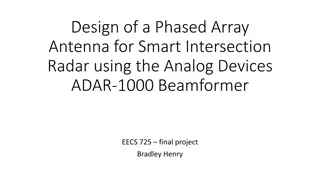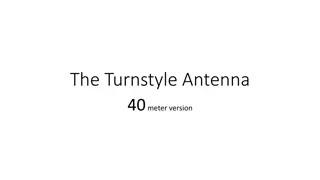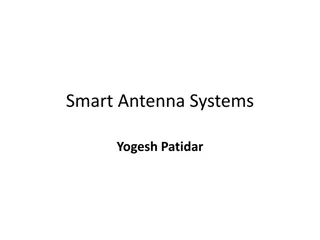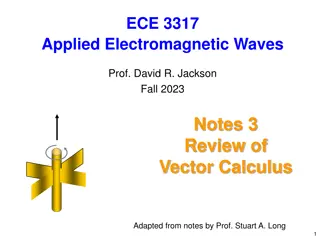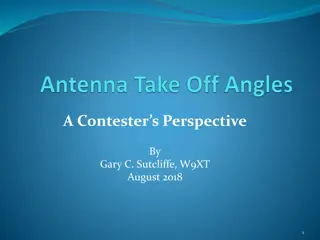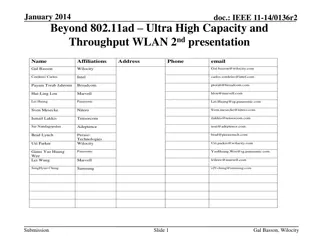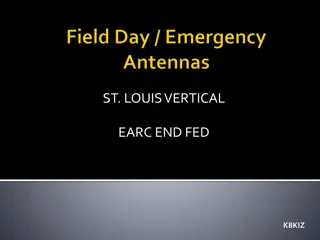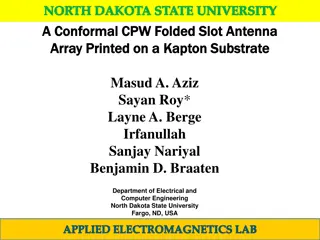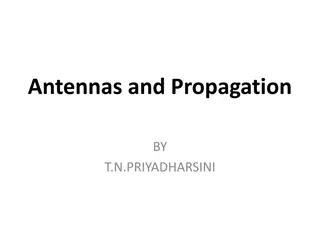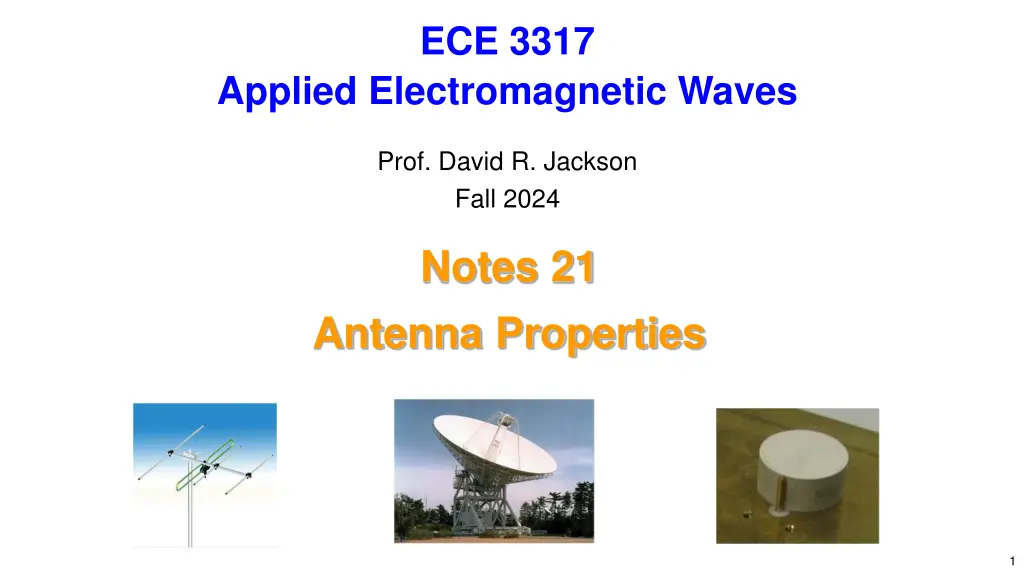
Understanding Antenna Radiation Patterns and Far-field Characteristics
Explore the concept of antenna radiation, far-field properties, and normalized patterns for optimal signal transmission. Learn about E and H-planes, power density in the far field, and more in this comprehensive guide.
Download Presentation

Please find below an Image/Link to download the presentation.
The content on the website is provided AS IS for your information and personal use only. It may not be sold, licensed, or shared on other websites without obtaining consent from the author. If you encounter any issues during the download, it is possible that the publisher has removed the file from their server.
You are allowed to download the files provided on this website for personal or commercial use, subject to the condition that they are used lawfully. All files are the property of their respective owners.
The content on the website is provided AS IS for your information and personal use only. It may not be sold, licensed, or shared on other websites without obtaining consent from the author.
E N D
Presentation Transcript
ECE 3317 Applied Electromagnetic Waves Prof. David R. Jackson Fall 2024 Notes 21 Antenna Properties 1
Antenna Radiation We consider here the radiation from an antenna. 1 2 = E H * S z S = Poynting vector ( ) r r , , r "far field" r +- y x jk r e 0 ( ) ( ) , , = FF , E r E r (phasor electric field) The far-field radiation acts like a plane wave going in the radial direction. The shape of the pattern in the far field is only a function of ( , ). 2
Antenna Radiation (cont.) How far do we have to go to be in the far field? Sphere of minimum diameter D that encloses the antenna. ( ) r r , , r +- D 2 2D r 0 3
Antenna Radiation (cont.) The far-field has the following form: Example: vertical dipole z ( ) = + E E E phasor electric field vector H ( ) = + H H H TMz phasor magnetic field vector S E H = y 0 E x Depending on the type of antenna, either or both polarizations may be radiated (e.g., a vertical wire antenna radiates only E polarization). Example: horizontal loop antenna z E TEz S E H = y 0 H x 4
Antenna Radiation (cont.) The power density in the far field is: ( ) 1 2 ( ) 2 , , = + r E S r E 2 0 or 2 E ( ) , , = r S r 2 0 5
Antenna Radiation (cont.) The far field always has the following form: jk r e 0 ( ) ( ) , , = FF , E r E r ( ) Normalized ar -field electric field vector f FF , E In decibels (dB): ( ) FF , E ( ) = dB , 20log ( ) 10 FF , E m m ( ) = direction of maximum radiation , m m 6
Antenna Radiation (cont.) A normalized far-field pattern is usually shown vs. the angle (for a fixed angle = 0) in polar coordinates. ( ) FF , E ( ) The subscript m denotes the beam maximum. 0 = dB , 20log ( ) 0 10 FF , E 0 m z An elevation cut 30 30 60 60 0o dB -9 -6 -3 0 120 120 150 150 7
Antenna Radiation (cont.) E-plane and H-plane E-plane Example: Microstrip antenna Current flow H-plane Feed E-plane: the plane containing the E vector. = E E H-plane: the plane containing the H vector. = H H Note: For the vertical dipole antenna, every elevation cut is an E plane. 8
Radiated Power The Poynting vector in the far field is 1 2 = E H * S z 2 ( 2 ) FF , E 1 r ( ) r r ( ) , , , , = 2 r W/m S r 2 r 0 +- y The total power radiated (in Watts) is then given by x 2 ( 2 ) FF , E 2 2 ( ) = S r r = 2 sin sin P d d d d rad 0 0 0 0 0 Hence, we have 2 1 2 ( ) = FF , sin P E d d rad 2 0 0 0 9
Directivity The directivity of the antenna in the directions ( , ) is defined as ( ) , rS ( ) , D r ( ) 2 / 4 P r rad The directivity (in a particular direction) is the ratio of the actual power density radiated in that direction to the power density that would be radiated in that direction if the antenna were an isotropic radiator (radiates equally in all directions). In dB, ( ) ( ) = , 10log , D D dB 10 Note:The directivity is sometimes referred to as the directivity with respect to an isotropic radiator. 10
Directivity (cont.) The directivity is then directly expressed in terms of the far field pattern: ( ) , rS ( ) , D r ( ) 2 / 4 P r 2 ( ) FF 4 , E rad ( ) = , D 2 ( 2 ) FF 2 , E 1 r 2 ( ) ( ) , , = 2 FF r W/m S r , sin E d d 2 0 0 0 2 1 2 ( ) = FF , sin P E d d rad 2 0 0 0 Usually, the directions are chosen to corresponds to the main beam direction: ( ) = D , D m m 11
Directivity (cont.) z z 30 30 30 30 60 60 60 60 0 dB 0 dB -6 -6 -3 -3 -9 -9 120 120 120 120 150 150 150 150 Antenna with moderate directivity (e.g., dipole) Antenna with high directivity (e.g., horn or dish) 12
Directivity (cont.) Two Common Cases: Dipole Antennas = / 2 m ( ) = = D / 2, D D Short dipole wire antenna (l << 0): D = 1.5 max Resonant half-wavelength dipole wire antenna (l = 0 / 2): D = 1.643 z Short dipole E Wire dipole antenna z sin = z h 30 30 60 60 = 2 l h Feed 0 dB y -6 -3 -9 120 120 x = z h 150 150 13
Beamwidth The beamwidth measures how narrow the beam is (the narrower the beamwidth, the higher the directivity). HPBW = half-power beamwidth At the half-power points: The power density is down by a factor of 1/2. The field is down by a factor of 1/ 2 = 0.707. In dB, we are down by 3 dB. 14
Sidelobe Level The sidelobe level measures how large the sidelobes are. In this example the sidelobe level is about -13 dB. Main beam Sidelobe level 13dB Sidelobes 15
Gain and Efficiency The radiation efficiency of an antenna is defined as P Prad= power radiated by the antenna Pin= power input to the antenna rad P e r in The gain of an antenna in the directions ( , ) is defined as ( ) , G ( ) , e D r In dB, we have ( ) ( ) = , 10log , G G dB 10 16
Gain and Efficiency (cont.) The gain tells us how strong the radiated power density is in a certain direction, for a given amount of input power. Recall that ( ) , rS ( ) , D r ( ) 2 / 4 P r rad Therefore, in the far field: ( ) ( ) ( ) = 2 , / 4 , rS P r D rad P Recall: rad P e r in ( ) ( ) ( ) = 2 , / 4 , S e P r D in r r ( ) ( ) Recall: , , G e D r ( ) ( ) ( ) = 2 , / 4 , rS P r G in 17
Input Impedance The antenna acts like a load impedance during transmit. Z = + Z R jX 0 in in in At resonance, the input reactance Xin is zero (the desired situation). Note: We usually want a match between the input impedance and the characteristic impedance Z0 of the feeding transmission line, to avoid reflection. 18
Input Impedance (cont.) At resonance: Z 73 0/ 2 L Dipole: in Current 0/ 4 Z h h 36.5 Monopole: in Feeding coax 19
Receive Antenna The Th venin equivalent circuit of an antenna being used as a receive antenna is shown below. The Thevenin impedance is the same as the input impedance of the antenna. + V inc E Th - = Z Z Z Th in = 2 l h Th + - V Th 20
Receive Antenna (cont.) The power received by an optimum conjugate-matched load: = + Z R jX Th Th Th Load +- ANT V = = * Th Z Z R jX Th Th Th L Prec = PL = power absorbed by load For a resonant dipole wire antenna: = = 0 X X Th in = = 73 [ ] R R = = 73 [ ] R opt L 73 [ ] R Th in Th 21
Receive Antenna (cont.) We can find the power received using an effective area. Receive circuit: Assume an optimum conjugate-matched load: Prec = PL = power absorbed by load Z Th + - V ANT = * Th Z Z Th L inc d = P A P rec eff = effective area of antenna A eff = inc 2 W/m dP power density of incident wave 22
Receive Antenna (cont.) We have the following general formula*: 2 0 = A G eff 4 G = G( , ) = gain of antenna in direction ( , ) (Usually, we assume that ( , ) is in the main beam direction.) *A derivation is given in the following book: C. A. Balanis, Antenna Engineering, 3rd Ed., 2016, Wiley. 23
Receive Antenna (cont.) Effective area of a lossless resonant half-wave dipole antenna: Assuming normal incidence ( = 90o): 2 0 = A G + V eff 4 inc E Th - 2 0 = ( ) 2 l h = = = 1.643 D D 1.643 max 4 ( ) 2 4 2 Assume lossless antenna: er= 100% (G = D) l ( ) = 0/ 2 = l 1.643 Hence: Note: = The dipole will receive more power at a lower frequency (larger l), assuming the same incident power. 2 0.523 A l eff 24
Example with Wire Antennas Example Find the received power Prec in the example below, assuming that the receiver is connected to an optimum conjugate-matched load. f = 1 [GHz] ( 0 = 0.29979 [m]) Assume lossless antennas: er= 100% (G = D) Pin = 10 [W] r = 1 [km] z Receive antenna (RX) = Transmit antenna (TX) P inc 2 W/m dP in P P rec L r = o 90 x = = * Th 73 [ ] Z Z L Resonant dipoles P rad 25
Example with Wire Antennas (cont.) = inc d P A P rec eff Gain of TX Gain of RX 2 0 P ( ) = inc d = 21.643 P in r 1.643 A eff 4 4 Hence: 2 0 P ( ) 1.643 = 1.643 P in r rec 2 4 4 The result is: = 8 1.54 10 [W] P rec 26
Receive Antenna (cont.) Effective area of dish (reflector) antenna In the maximum gain (main beam) direction: = A phy ap A e Now it is the effective area that we know, and from this we can calculate the gain. eff Aphy = physical area of dish eap= aperture efficiency 2 0 = A G eff 4 The aperture efficiency is usually less than 1 (less than 100%). 27
Gain of Dish Antenna Dish antenna: Obtaining a higher gain means having a larger dish. 4 = G A eff 2 0 = A phy ap A e eff A phy 2 0 = 4 G e ap 28
Example with Dish Antenna Example A microstrip antenna on a CubeSat with a gain of 8 (9.03 dB) transmits with an input power of 1 [W] at 10.0 GHz from a distance of 50,000,000 [km] (near Mars). How much power will be received by the NASA Deep Space Network dish at Goldstone, CA, which has a diameter of 70 [m]? Assume an aperture efficiency of 0.75 (75%). Express answer in Watts and in dBm (dB relative to a milliwatt). P dBm rec P Note: 10log rec 10 0.001[W] 29
Example with Dish Antenna (cont.) Example (cont.) Parameters: m = 5.0 10 10 = = r inc d inc d P P A P A e rec eff phy ap ( ) 2 = 2 70/ 2 m A P phy = inc d P in r G = 0.75 e trans 2 4 ap = 1 W 8 = P G in = 19 1.014 W P trans rec = dBm rec P 151.3 30

